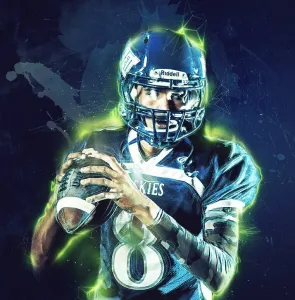Here’s a sample of the kind of material provided in the QB Manual:
(In the book, several diagrams accompany each description of coverage)
MOFO stands for Middle of Field OPEN
MOFC stands for Middle of Field CLOSED
- Identifying the number of safeties helps the quarterback narrow down the potential coverages the defense can run.
- The main thing to determine when reading coverages is how the defense is going to defend the deep middle of the field.
- By seeing how the defense will cover the deep middle of the field, the QB can figure out how they will defend the rest of the field.

The QB needs to determine the defensive coverage from among these options:
Cover 1: Man-Man coverage. (MOFC). There is 1 deep defender. (Man-free means there is one Safety who covers the field deep).
Cover 2: Zone coverage. (MOFO). There are 2 deep defenders. Each defender covers 1/2 of the field.
Cover 3: Zone coverage. (MOFC). There are 3 deep defenders. Each defender covers 1/3 of the field.
Cover 4: Zone coverage. (MOFO). There are 4 deep defenders. Each defender covers 1/4 of the field (quarters coverage).
The QB needs to determine which is the alignment:
- Is the Middle of the Field OPEN (MOFO)?
- Is the Middle of the Field CLOSED (MOFC)?
The QB Pre-Snap Read Progression:
During the pre-snap read the QB determines which half of the field he’s going to attack, basically eliminating the other half in his passing progression.
This is called a pre-snap, split field read and is effective when the defense plays primarily one coverage and doesn’t disguise.
When the QB approaches the line of scrimmage, his process should be as follows:
Begin by “looking through the goalposts” to find the location of the deep defenders and determine if the middle of the field is open or closed.
Next, scan left to right but do not focus on any specific area of the field. Just scan the defense – do not stare.
Specifically, the QB is trying to identify:
• Is the defense playing Cover 1, 2, 3 or 4 deep pass coverage?
• Safety alignment: One or two safeties?
• Cornerback alignment: What’s their depth?
• Linebacker alignment: Will they blitz?
• Has a defender already shut off an intended passing lane?
• Who is the contain man – important on sprint-out & option plays.
(Let’s assume it’s MOFO.)
1) Look at the Safeties. MOFO coverage means that there is no deep defender responsible to cover the middle of the field.
This is the result of the defense putting two Safeties back, usually on or near the hash marks.
This leaves the deep middle open and usually indicates Cover 2 or Cover 4.
2) Look at the Cornerbacks. Once it’s determined that the coverage is MOFO, the QB then looks at the CBs to see if their
alignments indicate who is responsible for defending the flats. If the CBs are close to the LOS, usually they are responsible for the flats.
If CBs are deeper, the OLB is probably responsible for the flats.
Two Deep Safeties: With two deep safeties, deeper passes can be harder to complete. Generally, two-deep coverage has each safety covering 1/2 of the field which makes pass plays up the middle easier to complete since the middle of the field is open.
• Zone coverage indicators: Corners are off the receivers (not pressing), hips turned, eyes looking inside at the QB.
• Man coverage indicators: Corners are tight to WR, (inside 5 yards) and if in press coverage, very tight to WR, hips are square to WR, eyes are on WR.
In most cases the alignment of the defenders will reveal the coverage, although this is sometimes changed after the snap of the ball.
After receiving the snap: The QB focuses on one receiver and one area to throw the football.
The first thing to identify is: where’s the open grass?
“I tell them to look to the area. You look to the slant area, to the curl area. If there’s nothing between you and him, throw it in there. If there’s someone in the throwing lane, then go to the next read.”
~ Mark Richt, former Head Coach, Georgia Bulldogs and Miami Hurricanes
If a Pass Play is Called: Once the QB has identified the defense, he should register a few things:
- What is the weakness of the defense?
- What is the defense giving us and what is it designed to take away?
- Which of the routes called will best attack the weakness.
- Which receivers give the best chance for a pass completion.
If Either a Run or Pass Play is Called: Once the defense is identified, there’s no need to change the play,
since the younger QB and his teammates usually are not yet ready to adapt to a play change, although
as the season progresses and players gain experience, they may be able to utilize simple sight adjustments.
Determined and committed study will help the QB to quickly determine which plays will provide the best chance to succeed.
